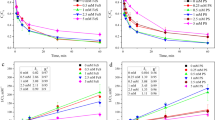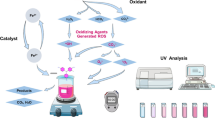Abstract
Pharmaceuticals have recently emerged as a significant environmental concern due to the growth of population, expansion of industry, and the shift in modern lifestyles. Herein, we present a Fe(II)/percarbonate (SPC) process with dramatically enhanced efficiency by the introduction of zerovalent iron (ZVI). After the addition of ZVI, the removal rate of nizatidine (NZTD) went up from 71.7 to 84.2%. The removal rate of NZTD decreases with rising pH and speeds up with increasing temperature. It was found that under the condition of pH = 7 and T = 25 °C, the molar ratio of the optimal concentration of NZTD degradation in the system was [NZTD]0:[SPC]0:[Fe(II)]0:[ZVI]0 = 1:8:24:16, with a degradation rate of 99.8%. At the same time, target pollutants can also be successfully eliminated from actual water bodies. Moreover, we test for toxicity using luminescent bacteria, and the results demonstrate that the system is capable of effectively decreasing the toxicity of NZTD. The research findings can contribute to the clarification of the migration and transformation law of NZTD in the oxidation process, thereby providing a scientific basis and technical support for the removal of NZTD in the tertiary water treatment for a water source.











Similar content being viewed by others
Data availability
The data that support the findings of this work are available from the corresponding author.
References
Besse J-P, Garric J (2008) Human pharmaceuticals in surface waters: implementation of a prioritization methodology and application to the French situation. Toxicol Lett 176:104–123. https://doi.org/10.1016/j.toxlet.2007.10.012
Bokare AD, Choi W (2014) Review of iron-free Fenton-like systems for activating H2O2 in advanced oxidation processes. J Hazard Mater 275:121–135. https://doi.org/10.1016/j.jhazmat.2014.04.054
Buxton GV, Greenstock CL, Helman WP, Ross AB (1988) Critical review of rate constants for reactions of hydrated electrons, hydrogen atoms and hydroxyl radicals (OH/O — in aqueous solution). J Phys Chem Ref Data 17:513–886. https://doi.org/10.1063/1.555805
Chen C, Shi X, Yang Z et al (2019) An integrated method for controlling the offensive odor and suspended matter originating from algae-induced black blooms. Chemosphere 221:526–532. https://doi.org/10.1016/j.chemosphere.2019.01.072
Choi K, Kim Y, Park J et al (2008) Seasonal variations of several pharmaceutical residues in surface water and sewage treatment plants of Han River, Korea. Sci Total Environ 405:120–128. https://doi.org/10.1016/j.scitotenv.2008.06.038
Cui H, Gu X, Lu S et al (2017) Degradation of ethylbenzene in aqueous solution by sodium percarbonate activated with EDDS–Fe(III) complex. Chem Eng J 309:80–88. https://doi.org/10.1016/j.cej.2016.10.029
De Laat J, Dao YH, Hamdi El Najjar N, Daou C (2011) Effect of some parameters on the rate of the catalysed decomposition of hydrogen peroxide by iron(III)-nitrilotriacetate in water. Water Res 45:5654–5664. https://doi.org/10.1016/j.watres.2011.08.028
de Luna MDG, Sablas MM, Hung C-M et al (2020) Modeling and optimization of imidacloprid degradation by catalytic percarbonate oxidation using artificial neural network and Box-Behnken experimental design. Chemosphere 251:126254. https://doi.org/10.1016/j.chemosphere.2020.126254
Dong H, Qiang Z, Lian J, Qu J (2017) Degradation of nitro-based pharmaceuticals by UV photolysis: kinetics and simultaneous reduction on halonitromethanes formation potential. Water Res 119:83–90. https://doi.org/10.1016/j.watres.2017.04.049
Du Y, Lv X-T, Wu Q-Y et al (2017) Formation and control of disinfection byproducts and toxicity during reclaimed water chlorination: a review. J Environ Sci 58:51–63. https://doi.org/10.1016/j.jes.2017.01.013
Fu X, Gu X, Lu S et al (2015) Benzene depletion by Fe2+-catalyzed sodium percarbonate in aqueous solution. Chem Eng J 267:25–33. https://doi.org/10.1016/j.cej.2014.12.104
Fu X, Dionysiou DD, Brusseau ML et al (2018) Enhanced effect of EDDS and hydroxylamine on Fe(II)-catalyzed SPC system for trichloroethylene degradation. Environ Sci Pollut Res Int 25:15733–15742. https://doi.org/10.1007/s11356-018-1708-9
Gamarra-Güere CD, Dionisio D, Santos GOS et al (2022) Application of Fenton, photo-Fenton and electro-Fenton processes for the methylparaben degradation: a comparative study. J Environ Chem Eng 10:106992. https://doi.org/10.1016/j.jece.2021.106992
Georgi A, Schierz A, Trommler U et al (2007) Humic acid modified Fenton reagent for enhancement of the working pH range. Appl Catal B 72:26–36. https://doi.org/10.1016/j.apcatb.2006.10.009
Han X, Lu H, Gao Y et al (2020) The role of in situ Fenton coagulation on the removal of benzoic acid. Chemosphere 238:124632. https://doi.org/10.1016/j.chemosphere.2019.124632
Huang J, Zhou Z, Ali M et al (2021) Degradation of trichloroethene by citric acid chelated Fe(II) catalyzing sodium percarbonate in the environment of sodium dodecyl sulfate aqueous solution. Chemosphere 281:130798. https://doi.org/10.1016/j.chemosphere.2021.130798
Iwagami M, Kumazawa R, Miyamoto Y et al (2021) Risk of cancer in association with ranitidine and nizatidine vs other H2 blockers: analysis of the Japan Medical Data Center Claims Database 2005–2018. Drug Saf 44:361–371. https://doi.org/10.1007/s40264-020-01024-0
Junges C, Vidal E, Attademo A et al (2013) Effectiveness evaluation of glyphosate oxidation employing the H2O2/UVC process: toxicity assays with Vibrio fischeri and Rhinella arenarum tadpoles. J Environ Sci Health B 48:163–170. https://doi.org/10.1080/03601234.2013.730011
Khetan SK, Collins TJ (2007) Human pharmaceuticals in the aquatic environment: a challenge to Green Chemistry. Chem Rev 107:2319–2364. https://doi.org/10.1021/cr020441w
Kumar A, Naushad M, Rana A et al (2017) ZnSe-WO3 nano-hetero-assembly stacked on Gum ghatti for photo-degradative removal of Bisphenol A: symbiose of adsorption and photocatalysis. Int J Biol Macromol 104:1172–1184. https://doi.org/10.1016/j.ijbiomac.2017.06.116
László W, Tóth T, Takács E (2022) Rate constants of carbonate radical anion reactions with molecules of environmental interest in aqueous solution: a review. Sci Total Environ 717:13721. https://doi.org/10.1016/j.scitotenv.2020.137219
Li L, Huang J, Hu X et al (2019) Activation of sodium percarbonate by vanadium for the degradation of aniline in water: mechanism and identification of reactive species. Chemosphere 215:647–656. https://doi.org/10.1016/j.chemosphere.2018.10.047
Liu J, Dong C, Deng Y, Ji J, Bao S, Chen C, Shen B, Zhang J, **ng M (2018) Molybdenum sulfide co-catalytic Fenton reaction for rapid and efficient inactivation of Escherichia coli. Water Res 145:312–320. https://doi.org/10.1016/j.watres.2018.08.039
Lyu Y, Lyu S, Tang P et al (2020) Degradation of trichloroethylene in aqueous solution by sodium percarbonate activated with Fe(II)-citric acid complex in the presence of surfactant Tween-80. Chemosphere 257:127223. https://doi.org/10.1016/j.chemosphere.2020.127223
Marzouqi FA, Al-Balushi NA, Kuvarega AT et al (2021) Thermal and hydrothermal synthesis of WO3 nanostructure and its optical and photocatalytic properties for the degradation of cephalexin and nizatidine in aqueous solution. Materials Science and Engineering: B 264:114991. https://doi.org/10.1016/j.mseb.2020.114991
Miao Z, Gu X, Lu S et al (2015) Perchloroethylene (PCE) oxidation by percarbonate in Fe2+-catalyzed aqueous solution: PCE performance and its removal mechanism. Chemosphere 119:1120–1125. https://doi.org/10.1016/j.chemosphere.2014.09.065
Nalliah RE (2019) Reaction of FD&C Blue 1 with sodium percarbonate: multiple kinetics methods using an inexpensive light meter. J Chem Educ 96:1453–1457. https://doi.org/10.1021/acs.jchemed.8b00589
Pignatello JJ, Oliveros E, MacKay A (2006) Advanced oxidation processes for organic contaminant destruction based on the Fenton reaction and related chemistry. Crit Rev Environ Sci Technol 36:1–84. https://doi.org/10.1080/10643380500326564
Qian Y, Huang J, Liu X et al (2020) Rapid oxidation of histamine H2-receptor antagonists by peroxymonosulfate during water treatment: kinetics, products, and toxicity evaluation. Water Res 185:116278. https://doi.org/10.1016/j.watres.2020.116278
Rahim Pouran S, Abdul Aziz AR, Wan Daud WMA (2015) Review on the main advances in photo-Fenton oxidation system for recalcitrant wastewaters. J Ind Eng Chem 21:53–69. https://doi.org/10.1016/j.jiec.2014.05.005
Rao PV, Kumar MR, Prasad V, Rao DD (2014) Stability-indicating LC method for the estimation of nizatidine impurities in nizatidine oral solution. J Liq Chromatogr Relat Technol 37:1065–1078. https://doi.org/10.1080/10826076.2013.765461
Rott E, Minke R, Bali U, Steinmetz H (2017) Removal of phosphonates from industrial wastewater with UV/FeII, Fenton and UV/Fenton treatment. Water Res 122:345–354. https://doi.org/10.1016/j.watres.2017.06.009
Sanad MH,Saleh GM,Marzook FA (2017) 尼扎替丁作为用于消化性溃疡病检测的新型高选择性放射性示踪剂的放射性碘化和生物学评估。J 标记为 Comp Radiopharm 60:600–607。https://doi.org/10.1002/jlcr.3541
Shen R, Andrews SA (2011) 在氯胺消毒过程中演示20种药品和个人护理产品(PPCPs)作为亚硝胺前体。水研究45:944-952。https://doi.org/10.1016/j.watres.2010.09.036
Vela N, Calín M, Yáñez-Gascón MJ 等人 (2019) 使用ZnO/Na的太阳能多相光催化去除废水废水中具有内分泌干扰物活性的农药2S2O8.水空气土壤污染230:134。https://doi.org/10.1007/s11270-019-4185-y
Venny, Gan S, Ng HK (2012) 多环芳烃(PAH)污染土壤的无机螯合改性芬顿处理。化学工程杂志180:1-8。https://doi.org/10.1016/j.cej.2011.10.082
Vicente F,Rosas JM,Santos A,Romero A (2011)通过在类似芬顿的过程中使用稳定剂和螯合剂来改善土壤修复。化学工程杂志172:689-697。https://doi.org/10.1016/j.cej.2011.06.036
Viciosa MT,Moura Ramos JJ,Diogo HP (2016)无定形药物西咪替丁,尼扎替丁和法莫替丁中的缓慢松弛动力学。J Pharm Sci 105:3573–3584。https://doi.org/10.1016/j.xphs.2016.08.019
Viisimaa M,Goi A (2014)使用过氧化氢和过碳酸盐处理氯化芳烃污染的土壤。J 环境工程 马纳格 22:30-39。https://doi.org/10.3846/16486897.2013.804827
Wang T, Zhou Y, Cao S et al (2019) Fenton样反应降解磺胺并利用响应面方法优化。生态毒理环境安全172:334-340。https://doi.org/10.1016/j.ecoenv.2019.01.106
杨蓉, 曾国, 徐志 等 (2021) H脱萘性能比较2O2、过碳酸钠和过氧化钙氧化剂被亚铁离子活化及降解机理。化学圈283:131209。https://doi.org/10.1016/j.chemosphere.2021.131209
张斌彤, 张彦, 滕莹, 范敏 (2015) 硫酸根基及其在净化技术中的应用.Crit Rev Environ Sci Technol 45:1756–1800。https://doi.org/10.1080/10643389.2014.970681
Zhang S, Hu X, Li L et al (2018) 用亚铁离子活化过碳酸钠以降解水溶液中的氯苯:机制、途径和与过氧化氢的比较。环境化学14:486-494。https://doi.org/10.1071/EN17137
张炳棠, 匡林, 滕荹, 等 (2021) 过碳酸酯和过氧单碳酸酯在净化技术中的应用。环境科学杂志105:100-115。https://doi.org/10.1016/j.jes.2020.12.031
Funding
Our work was supported by the National Natural Science Foundation of China (Grant No. 51778267), the National Water Pollution Control and Treatment Science and Technology Major Project (No. 2012ZX07408001), the Jilin Province Science and Technology Department Project (No. 20190201113JC), and the Jilin Provincial Department of Ecology and Environment Project (No. 2019–15).
Author information
Authors and Affiliations
Contributions
Mingxin Huo: conceptualization, methodology, software, investigation, formal analysis, writing — original draft; Deqiang Zou: data curation, methodology, software, resources, investigation, supervision, formal analysis, writing — original draft; Yingzi Lin: conceptualization, funding acquisition, resources, supervision, writing — review and editing; Yi Lou: methodology, software, resources, investigation, supervision; Gen Liu: validation, investigation, supervision; Siwen Li: validation, investigation, supervision; Lei Chen: project administration, validation, investigation, supervision; BaoLing Yuan: project administration, validation, investigation, supervision; Qingyu Zhang: visualization, data curation, formal analysis; Ao Hou: visualization, data curation, formal analysis.
Corresponding author
Ethics declarations
Ethical approval
Not applicable.
Consent to participate
Not applicable.
Consent for publication
The author agrees to publication in the journal indicated below and also to publication of the article in English by Springer in Springer’s corresponding English-language journal.
The copyright to the English-language article is transferred to Springer effective if and when the article is accepted for publication. The author warrants that his/her contribution is original and that he/she has full power to make this grant. The author signs for and accepts responsibility for releasing this material on behalf of any and all co-authors. The copyright transfer covers the exclusive right to reproduce and distribute the article including reprints, translations, photographic, reproductions, microform, electronic form (offline, online), or any other reproductions of similar nature.
After submission of the agreement signed by the corresponding author, changes of authorship or in the order of the authors listed will not be accepted by Springer.
Competing interests
The authors declare no competing interests.
Additional information
Responsible Editor: Ricardo A. Torres-Palma
Publisher's note
Springer Nature remains neutral with regard to jurisdictional claims in published maps and institutional affiliations.
Supplementary Information
Below is the link to the electronic supplementary material.
Rights and permissions
Springer Nature or its licensor (e.g. a society or other partner) holds exclusive rights to this article under a publishing agreement with the author(s) or other rightsholder(s); author self-archiving of the accepted manuscript version of this article is solely governed by the terms of such publishing agreement and applicable law.
About this article
Cite this article
Huo, M., Zou, D., Lin, Y. et al. Enhanced degradation of emerging contaminants by percarbonate/Fe(II)-ZVI process: case study with nizatidine. Environ Sci Pollut Res 30, 53309–53322 (2023). https://doi.org/10.1007/s11356-023-25876-y
Received:
Accepted:
Published:
Issue Date:
DOI: https://doi.org/10.1007/s11356-023-25876-y




